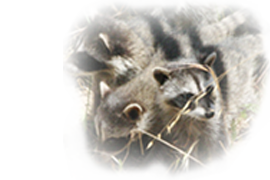Self-Help
General Information
Identify the animal
In the event that an animal has taken up residence under a home the first method of removal should be exclusion. The first step is to identify the animal you are trying to exclude. It is important to know what the animal is. If you know the type of animal, it tells us the likelihood of baby animals living in the structure with them.
You can read more about common wild animals by clicking the links to right.
Predator scent
Predator scent is coyote or Mountain Lion excrement that is applied to areas of your yard where wildlife is seen most often. The wild animals smell the scent of the predator and choose to leave your yard. Predator scent can be purchased through Sonoma County Wildlife Rescue located at 403 Mecham Rd, Petaluma Ca. for $25.00 per quart sized bag. There are other "urine" like products available at many home and garden stores.
Most common attractants
Food is the most common attractant. Do not leave pet food out or you should bring it in after the pet is done. The garbage containment situation should be looked into because it can be a key attractant. Sometimes grubs in the soil are the food desired by the animal. Reduced watering or turf treatment will often remove or reduce the grub attraction. A product called Milky Spore is available from online merchants; one application lasts for 10 years or more.
Shelter is the next most common attractant, especially in the spring when babies are born.
If it is likely baby animals are under the structure
If they have young, under most circumstances one must wait until the young are old enough to walk out on their own. Trapping young in a structure will not only make the mother furious, but they will eventually die and become an odor problem. There is also the potential problem of parasites such as fleas, mites or ticks that will now be in search of a new host.
The mother will care for and nurse the young for a number of weeks (depending on animal type), until they can walk and venture forth with the mother. SCWR can tell you how long it generally takes for babies to become mobile.
For detailed information about birthing and weaning of local wildlife,
click on Animal Birthing Season Chart
How to exclude animals from your home
Basic wildlife exclusion can be done by determining all possible entrances to the structure in question. After this is done, you need to find the most commonly used entrance. This may have to be done by the use of tracking powder. Talcum, flour, or baby powders are the best choices. Sprinkle a light coating around the opening during the day and recheck the next day. This may also tell you the number of animals.
Seal up all openings except the one used the most. Once all the other openings are sealed, you can prepare to exclude the animal. Prepare the building material that you will use to exclude the animal. Often this is as simple as buying a new vent screen, and having nails or screws ready to attach it in the opening. Sometimes you must be creative in coming up with a way to seal the opening. It must be stressed that a permanent solution is what is wanted.
Create something that only opens in one direction and will shut once an animal walks out. Often this can be a small piece of house siding with a hole cut out and then reattached with snap hinges. Prop it open and wait until it shuts. Continue to prop open until the door stops shutting for up to five days. At this point you will know the animals are out. When the animal returns there may be some scratching or digging around-- attempting to defeat the exclusion, but a good job will usually hold up. If there is continuing, furious attempts to reenter, this may be a sign that young are present!
It should be as simple as this in the majority of situations. The animals will move on to better habitat.
Animals digging up lawn
Use predator scent to deter animals from the area. This can be purchased at SCWR. Use milky spore to naturally deter the grubs that wildlife are seeking. This can be purchased at a local nursery. Take up all fruits and nuts as to make the area less attractive. Cayenne pepper, grub killing chemicals, predator scent, motion sprinkler, etc may also help.
How to discourage nighttime visits by wildlife
Remove pet foods left outside in feeding bowls. Cats only need to feed for 10 minutes in the morning and evening and food should be removed promptly after 10 minutes. Elevate woodpiles to discourage nesting, keep garbage can lids on tightly, place rags in a bowl of ammonia in areas you want to discourage wildlife, or use predator scent.
When is a wild animal a threat to pets?
When pet food is left out, wildlife will be attracted and potentially fight the pet over the food. Most pets especially cats will avoid wildlife at all costs, but dogs usually become aggressive to protect "their" territory. Pets should always come in at night, or be placed in a predator-proof enclosure if they do have to be left out at night. Animals only attack if they are feeling threatened. A dog barking at them will cause them to attack the dog.



